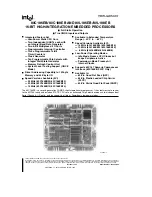
OPTIMOD-FM DIGITAL
OPERATION
3-3
Introduction to Processing
Some Audio Processing Concepts
Reducing the peak-to-average ratio of the audio increases loudness. If peaks are re-
duced, the average level can be increased within the permitted modulation limits.
The effectiveness with which this can be accomplished without introducing objec-
tionable side effects (such as pumping or intermodulation distortion) is the single
best measure of audio processing effectiveness.
Compression reduces the difference in level between the soft and loud sounds to
make more efficient use of permitted peak level limits, resulting in a subjective in-
crease in the loudness of soft sounds. It cannot make loud sounds seem louder. Com-
pression reduces dynamic range relatively slowly in a manner similar to riding the
gain: Limiting and clipping, on the other hand, reduce the short-term peak-to-
average ratio of the audio.
Limiting increases audio density. Increasing density can make loud sounds seem
louder, but can also result in an unattractive busier, flatter, or denser sound. It is im-
portant to be aware of the many negative subjective side effects of excessive density
when setting controls that affect the density of the processed sound.
Clipping sharp peaks does not produce any audible side effects when done moder-
ately. Listeners will perceive excessive clipping as audible distortion.
Look-ahead limiting is limiting that prevents overshoots by examining a few milli-
seconds of the unprocessed sound before it is limited. This way the limiter can an-
ticipate peaks that are coming up.
The 8300 uses look-ahead techniques in several parts of the processing to minimize
overshoot for a given level of processing artifacts (among other things).
Distortion in Processing
In a competently designed processor, distortion occurs only when the processor is
controlling peaks to prevent the audio from exceeding the peak modulation limits
of the transmission channel. The less peak control that occurs, the less likely that the
listener will hear distortion. However, to reduce the amount of peak control, you
must decrease the drive level to the peak limiter, which causes the average level
(and thus, the loudness) to decrease proportionally.
Loudness and Distortion
In FM processing, there is a direct trade-off between loudness, brightness, and dis-
tortion. You can improve one only at the expense of one or both of the others.
Thanks to Orban’s psychoacoustically optimized designs, this is less true of Orban
processors than of any others. Nevertheless, all intelligent processor designers must
acknowledge and work within the laws of physics as they apply to this trade-off.
Perhaps the most difficult part of adjusting a processor is determining the best
trade-off for a given situation. We feel that it is usually wiser to give up ultimate
loudness to achieve low distortion. A listener can compensate for loudness by simply
Summary of Contents for 8300J
Page 1: ...Operating Manual OPTIMOD FM 8300 Digital Audio Processor Version 2 1 Software...
Page 7: ...Operating Manual OPTIMOD FM 8300 Digital Audio Processor Version 2 1 Software...
Page 24: ......
Page 94: ...2 46 INSTALLATION ORBAN MODEL 8300 This page intentionally left blank...
Page 190: ......
Page 204: ......
Page 246: ......
Page 247: ...OPTIMOD FM DIGITAL TECHNICAL DATA 6 29...
Page 254: ...6 36 TECHNICAL DATA ORBAN MODEL 8300 CPU Module...
Page 260: ...6 42 TECHNICAL DATA ORBAN MODEL 8300 8300 RS232 BOARD PARTS LOCATOR...
Page 262: ...6 44 TECHNICAL DATA ORBAN MODEL 8300 8300 POWER SUPPLY PARTS LOCATOR...
Page 264: ...6 46 TECHNICAL DATA ORBAN MODEL 8300 8300 I O BOARD PARTS LOCATOR...
Page 270: ...6 52 TECHNICAL DATA ORBAN MODEL 8300 DSP BOARD PARTS LOCATOR DRAWING 32170 000 14...
Page 278: ...6 60 TECHNICAL DATA ORBAN MODEL 8300 8300 DISPLAY BOARD PARTS LOCATOR...
Page 279: ...OPTIMOD FM DIGITAL TECHNICAL DATA 6 61 DISPLAY BOARD...
















































